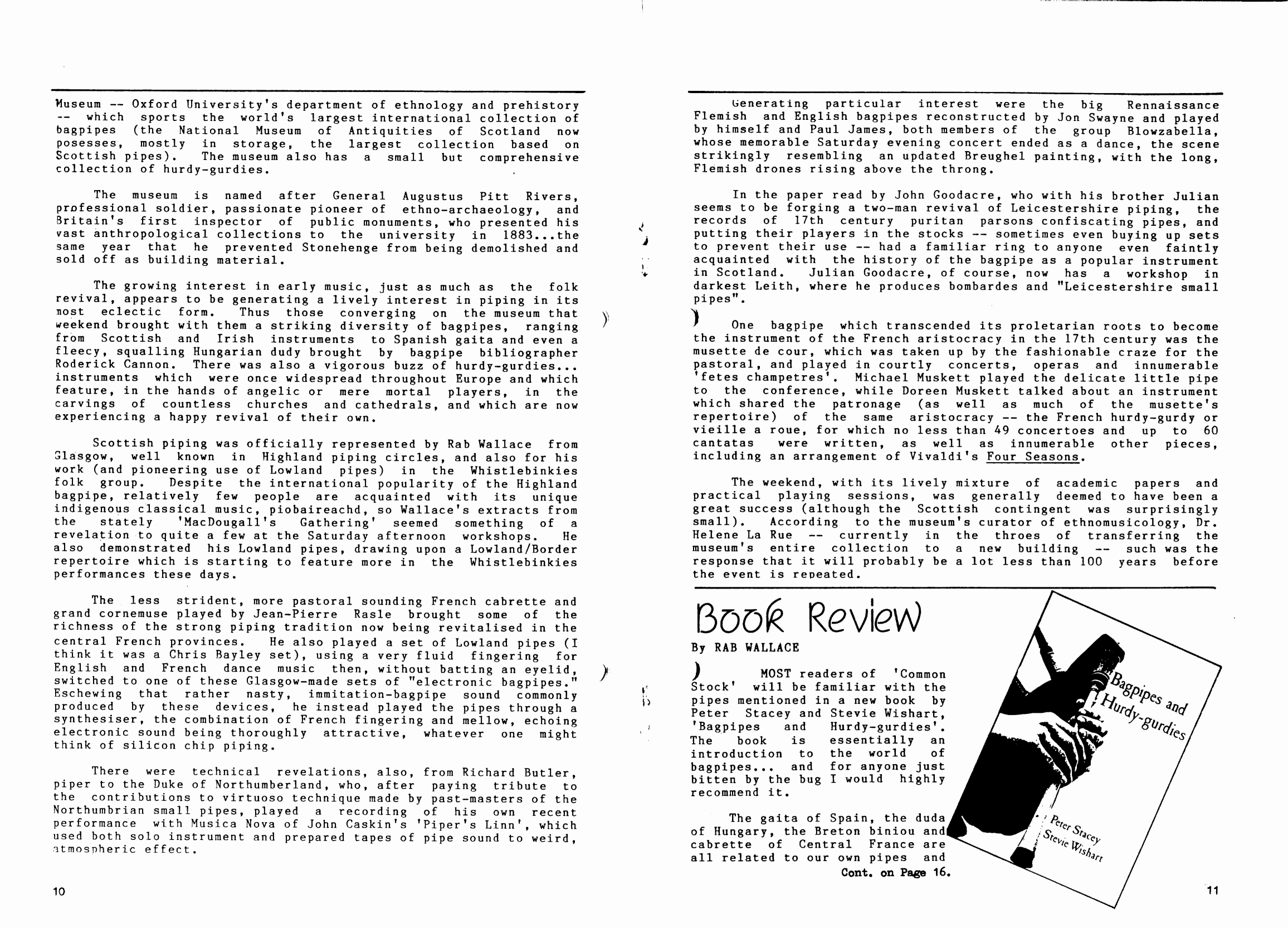One Big Blow At Pitt River Conference
JIM GILCHRIST was in Oxford last September for the centenary of the Pitt Rivers Museum, whose large collection of bagpipes provided the basis for Anthony Baines' book, ‘Bagpipes, published in 1960, Among the pipers attending the conference were Rab Wallace (right) and, from the group Blowzabella, Jon Swayne and Paul James (on left),
IT WAS enough to induce heart failure, or at least severe hyperventilation, in your more dyed-in-the-wool Scottish piper -- the type who adheres solidly to the maxim that there is but one pipe -- the Great Highland bagpipe -- and that thou shalt have no other bagpipes before it. Certainly there can have been few occasions in Britain when so many different types of bagpipe have been gathered and played, under the same roof.
The occasion was a conference on bagpipes and hurdy-gurdies in Oxford last September, celebrating the centenary of the Pitt Rivers Museum ~~ Oxford University's department of ethnology and prehistory -- which sports the world's largest international collection of bagpipes (the National Museum of Antiquities of Scotland now posesses, mostly in storage, the largest collection based on Scottish pipes). The museum also has a small but comprehensive collection of hurdy-gurdies.
The museum is named after General Augustus Pitt Rivers, professional soldier, passionate pioneer of ethno-archaeology, and Britain's first inspector of public monuments, who presented his vast anthropological collections to the university in 1883...the same year that he prevented Stonehenge from being demolished and sold off as building material.
The growing interest in early music, just as much as the folk revival, appears to be generating a lively interest in piping in its most eclectic form, Thus those converging on the museum that weekend brought with them a striking diversity of bagpipes, ranging from Scottish and Irish instruments to Spanish gaita and even a fleecy, squalling Hungarian dudy brought by bagpipe bibliographer Roderick Cannon. There was also a vigorous buzz of hurdy-gurdies... instruments which were once widespread throughout Europe and which feature, in the hands of angelic or mere mortal players, in the carvings of countless churches and cathedrals, and which are now experiencing a happy revival of their own, Scottish piping was officially represented by Rab Wallace from Glasgow, well known in Highland piping circles, and also for his work (and pioneering use of Lowland pipes) in the Whistlebinkies folk group. Despite the international popularity of the Highland bagpipe, relatively few people are acquainted with its unique indigenous classical music, piobaireachd, so Wallace's extracts from the stately "MacDougall's Gathering’ seemed something of a revelation to quite a few at the Saturday afternoon workshops. He also demonstrated his Lowland pipes, drawing upon a Lowland/Border repertoire which is starting to feature more in the Whistlebinkies performances these days.
The less strident, more pastoral sounding French cabrette and grand cornemuse played by Jean-Pierre Rasle brought some of the richness of the strong piping tradition now being revitalised in the central French provinces. He also played a set of Lowland pipes (I think it was a Chris Bayley set), using a very fluid fingering for English and French dance music then, without batting an eyelid, switched to one of these Glasgow-made sets of “electronic bagpipes." Eschewing that rather nasty, imitation-bagpipe sound commonly produced by these device s, he instead played the pipes through a synthesiser, the combination of French fingering and mellow, echoing electronic sound being thoroughly attractive, whatever one might think of silicon chip piping.
There were technical revelations, also, from Richard Butler, piper to the Duke of Northumberland, who, after paying tribute to the contributions to virtuoso technique made by pastmasters of the Northumbrian small pipes, played a recording of his own recent performance with Musica Nova of John Caskin's 'Piper's Linn', which used both solo instrument and prepared tapes of pipe sound to weird, atmospheric effect.
Generating particular interest were the big Rennaissance Flemish and English bagpipes reconstructed by Jon Swayne and played by himself and Paul James, both members of the group Blowzabella, whose memorable Saturday evening concert ended as a dance, the scene strikingly resembling an updated Breughel painting, with the long, Flemish drones rising above the throng,
In the paper read by John Goodacre, who with his brother Julian seems to be forging a twoman revival of Leicestershire piping, the records of 17th century puritan parsons confiscating pipes, and putting their players in the stocks -- sometimes even buying up sets to prevent their use -- had a familiar ring to anyone even faintly acquainted with the history of the bagpipe as a popular instrument in Scotland. Julian Goodacre, of course, now has a workshop in darkest Leith, where he produces bombardes and "Leicestershire small pipes".
One bagpipe which transcended its proletarian roots to become the instrument of the French aristocracy in the 17th century was the musette de cour, which was taken up by the fashionable craze for the pastoral, and played in courtly concerts, operas and innumerable "fetes champetres'. Michael Muskett played the delicate little pipe to the conference, while Doreen Muskett talked about an instrument which shared the patronage (as well as much of the musette's repertoire) of the same aristocracy -- the French hurdy-gurdy or vieille a roue, for which no less than 49 concertoes and up to 60 cantatas were written, as well as innumerable other pieces, including an arrangement of Vivaldi's Four Seasons, The weekend, with its lively mixture of academic papers and practical playing sessions, was generally deemed to have been a great success (although the Scottish contingent was surprisingly small), According to the museum's curator of ethnomusicology, Dr. Helene La Rue -- currently in the throes of transferring the museum's entire collection to a new building -- such was the response that it will probably be a lot less than 100 years before the event is repeated.


